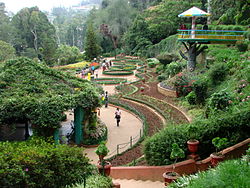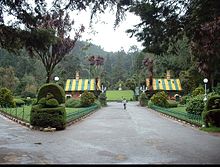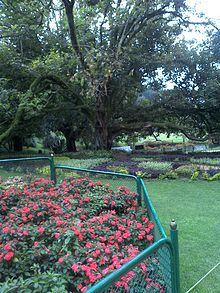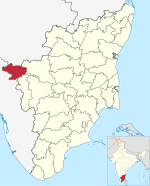
Ooty, abbreviated as Udagai) is a town and municipality in the Nilgiris district of the Indian state of Tamil Nadu. It is located 86 km (53 mi) northwest of Coimbatore, and is the headquarters of Nilgiris district. Situated in the Nilgiri hills, it is known by the epithet "Queen of Hill Stations", and is a popular tourist destination.

The Nilgiris district is one of the 38 districts in the southern Indian state of Tamil Nadu. Nilgiri is the name given to a range of mountains spread across the borders among the states of Tamil Nadu, Karnataka and Kerala. The Nilgiri Hills are part of a larger mountain chain known as the Western Ghats. Their highest point is the mountain of Doddabetta, height 2,637 m. The district is contained mainly within the Nilgiri Mountains range. The administrative headquarters is located at Ooty. The district is bounded by Coimbatore to the south, Erode to the east, and Chamarajnagar district of Karnataka and Wayanad district of Kerala to the north. As it is located at the junction of three states, namely, Tamil Nadu, Kerala, and Karnataka, significant Malayali and Kannadiga populations reside in the district. Nilgiris district is known for natural mines of Gold, which is also seen in the other parts of Nilgiri Biosphere Reserve extended in the neighbouring states of Karnataka and Kerala too.

The Chavez Ravine Arboretum, in Elysian Park, just north of Dodger Stadium, at 1025 Elysian Park Dr, Los Angeles, California, contains more than 100 varieties of trees from around the world, including what are believed to be the oldest and largest Cape Chestnut, Kauri, and Tipu trees in the United States. Admission to the arboretum is free.

Mounts Botanical Garden is a botanical garden located in West Palm Beach, Florida. It is Palm Beach County's oldest and largest public garden with over 7,000 species of tropical and subtropical plants from six continents, including plants native to Florida, exotic trees, tropical fruit, herbs, citrus and palms. Mounts Botanical is part of the Palm Beach County Cooperative Extension Department, in partnership with the University of Florida / IFAS and the nonprofit Friends of the Mounts Botanical Garden, Inc.

The Christchurch Botanic Gardens, located in the central city of Christchurch, New Zealand, were founded in 1863 when an English oak was planted to commemorate the solemnisation of the marriage of Prince Albert and Princess Alexandra of Denmark. The gardens sprawl over an area of 21 hectares and lie adjacent to the loop of the Avon River next to Hagley Park. The Christchurch Botanic Gardens have a variety of collections of exotic and local plants of New Zealand, several conservatories, a nursery, playground and Climatological Station.

The University of Delaware Botanic Gardens are botanical gardens and an arboretum located on the campus of the University of Delaware, in Newark, Delaware, United States. The gardens are open to the public without charge.

The Donald E. Davis Arboretum, in Auburn, Alabama, United States, is a public native plants museum, and botanical arboretum with educational facilities, event spaces, and a conservation program. Its grounds, covering 13.5 acres of Auburn University's campus, include cataloged living collections of associated tree and plant communities representative of Alabama's ecosystems, among which is mixed oak forest, carnivorous bog, and longleaf pine savanna. The living collections include more than 1,000 plant types, including 500 different plant species, with over 3,000 cataloged specimens. The Arboretum contains over a mile (2 km) of interwoven walking trails that meander through various southeastern biotopes.
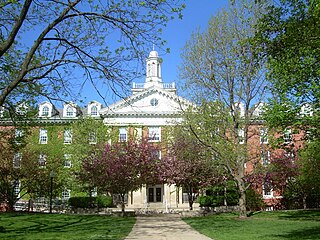
The Fell Arboretum is an arboretum located across the campus of Illinois State University in Normal, Illinois.

Peavy Arboretum is an arboretum operated by Oregon State University and located on Arboretum Road, Corvallis, Oregon. It is open to the public daily without charge.
The Plant Collections Network (PCN) is a group of North American botanical gardens and arboreta that coordinates a continent-wide approach to plant germplasm preservation, and promotes excellence in plant collections management. The program is administered by the American Public Gardens Association from its headquarters in Kennett Square, Pennsylvania, in collaboration with the USDA Agricultural Research Service.

The Sir Harold Hillier Gardens is an arboretum comprising 72 hectares accommodating over 42,000 trees and shrubs in about 12,000 taxa, notably a collection of oaks, camellia, magnolia and rhododendron.

The Morris Arboretum & Gardens of the University of Pennsylvania is the official arboretum of the Commonwealth of Pennsylvania. The Arboretum is open daily except for major holidays. It is located at 100 East Northwestern Avenue, Chestnut Hill, Philadelphia, Pennsylvania.
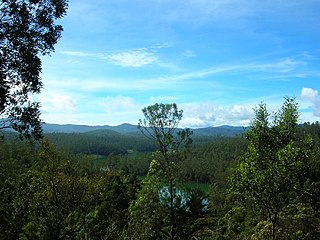
The Nilgiri Mountains form a part of the Western Ghats in northwestern Tamil Nadu, southern Karnataka and eastern Kerala in South India. They are located at the trijunction of the three states and connect the Western Ghats to the Eastern Ghats. At least 24 of the Nilgiri Mountains' peaks are above 2,000 m (6,600 ft), with the highest peak being Doddabetta at 2,637 m (8,652 ft).

The Arboretum de Villardebelle is an arboretum specializing in conifers located in Villardebelle, Aude, Languedoc-Roussillon, France.
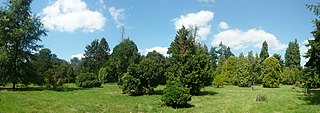
The Arboretum de Versailles-Chèvreloup is a major arboretum located just north of the Palace of Versailles at 30, route de Versailles, Rocquencourt, Yvelines, Île-de-France, France. It forms part of the Muséum national d'histoire naturelle, and is open everyday in the warmer months; an admission fee is charged.
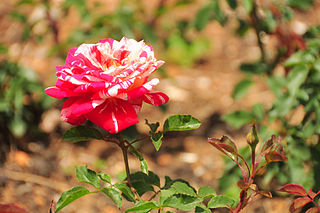
The Government Rose Garden is situated on the slopes of the Elk Hill in Vijayanagaram of Ooty town in Tamil Nadu, India at an altitude of 2200 meters.

Sim's Park is in Coonoor, The Nilgiris, Tamil Nadu. It is an important tourist place to visit in Coonoor, at a height of 1780 meters above mean sea level. Here the maximum temperature goes up to 28 degree Celsius and the minimum falls to 5 °C. The average rain fall of this garden is 150 cm. It extends over an area of 12 hectares of undulating land and possesses a number of natural advantages.

Summer Festival is a festival celebrated in the Nilgiri mountains of India each May. The festival is organized by the Tamil Nadu Department of Tourism and the national Ministry of Tourism. Events during the festival include cultural programmes, a Flower Show, a Rose Show, a Dog Show, a Fruit Show, a Spice Show, a Vegetable Show, a Boat Race, and Boat pageantry.
Ludwig Bernhard Ehregott Schmid was a German Lutheran clergyman and missionary who worked in India. Ill health led him to choose to live in Ootacamund and he spent considerable time examining local plants, and making collections of specimens, many of which were deposited in Jena where his cousin J. C. Zenker published a few descriptions but died too early to produce a more complete work. Several plant species have been named after Schmid including the fossil trees Peuce schmidiana and Mesembrioxylon schmidianum from Thiruvakkarai near Pondicherry.
